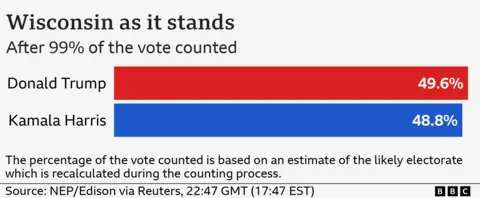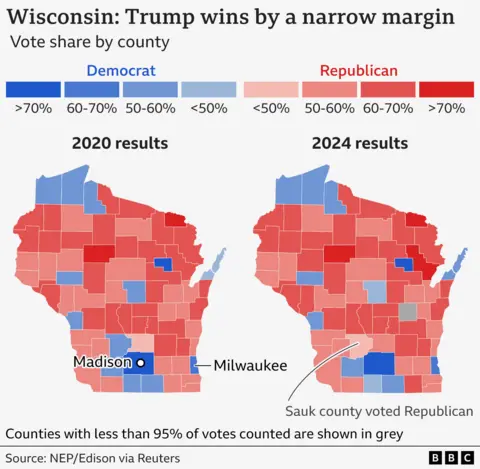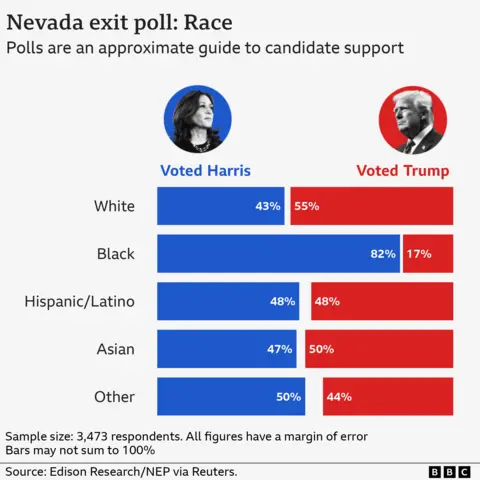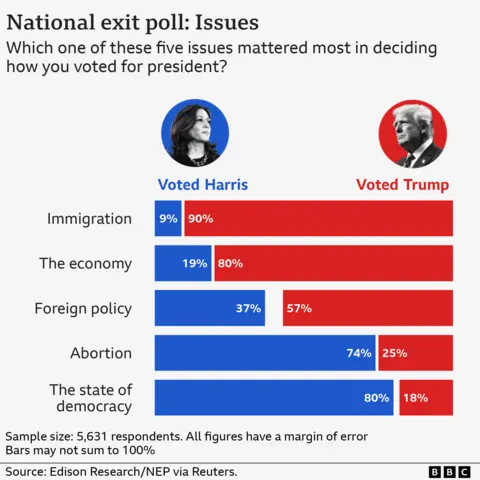 Getty Images
Getty ImagesDonald Trump has won the presidency of the United States, gaining a historic second term.
Votes are still being counted, but a picture is emerging of what tipped the balance in Trump’s favour: relatively small shifts in support in many different places.
The map below shows in red the states where Trump won. Kamala Harris’s victories are shown in blue.
For the data in the map, click here
Trump gathered the 270 electoral college votes needed to win after capturing three battleground states from the Democrats: Georgia, Pennsylvania and Wisconsin, shown in red stripes.
His margin of victory was slim in all three, but in Wisconsin he won by less than one percentage point – just over 28,000 votes at latest count.

It is difficult to identify a single group or area in the state that moved the needle towards Trump.
Neither party increased its share of the vote by more than 5% in any county across the state, compared with 2020. If you look at the map below the change is almost imperceptible.

Harris did well in her traditional urban strongholds of Milwaukee and Madison. Voters did come out for her in large numbers, yet it was Trump’s small but widespread gains in counties across the state that did the trick.
In 2020, Biden’s wins in Georgia and Pennsylvania were key to clinching the presidency.
This election, Trump took both states. The precise reason is unclear as votes are still being counted, but what is emerging is a similar pattern of slight but widespread shifts towards Trump.
Trump gains with Hispanic Nevadans
In the western battleground of Nevada, Trump is leading. In the vote tally so far, there has been little change among the largest groups of voters.
Black voters chose Harris in similar numbers as they did Biden, while white voters maintained their support for Trump.
Yet the exit poll suggested Trump saw a substantial increase in support among Hispanic and Asian voters, with Harris losing ground compared with Biden four years ago.
Trump raised his share among Hispanic voters by 13 points compared with 2020, which meant he and Harris ended up in a tie, both securing 48% of that vote.

He also enjoyed a very substantial swing among Nevada’s Asian voters, from 35% in 2020 to 57% in 2024.
While the Asian community accounts for just 4% of voters surveyed, we’ve seen how similarly small shifts made the difference elsewhere.
Margins of victory
A picture seems to be forming once again of a divide between rural and urban voters, as shown in the county level map below, although counting continues in many states particularly in the west.

Harris led by tens of thousands of votes in major cities across the country.
But Trump dominated the rural counties that lie between them. His wins may not appear to be as sizeable, but they are pervasive. And those margins add up.
People voted for change
While the picture in the states that flipped will become clearer in the coming days, we can see some emerging trends on how different groups of people voted across the nation from US exit polls.
These cut across demographic groups and regions.
On immigration and the economy, Trump was seen as the overwhelming favourite among voters for whom either was the most important issue.

For voters who felt strongly about abortion or the state of democracy, more than three in four voted for Harris.
This suggests a stark difference in priorities across the two groups of voters.
Both campaigns emphasised these diverging issues in recent weeks, and it’s clear the messaging cut through.
The personalities of the candidates themselves may also have played a role in how ballots were cast.
For those looking for a presidential candidate who would “bring needed change” to the country, a large majority voted for Trump. And two-thirds of those who most valued leadership skills did the same.

A large majority of Harris voters chose her because they felt she had good judgement and “cared about people like me”.
But the desire for change can be a powerful force when it comes to the way voters choose to cast their ballot.
Produced by Wesley Stephenson, Becky Dale, Christine Jeavans, Libby Rogers, Alison Benjamin, Zak Datson, Muskeen Liddar, Erwan Rivault, John Walton, Callum Thomson, Rob England, Phil Leake, Daniel Wainwright


